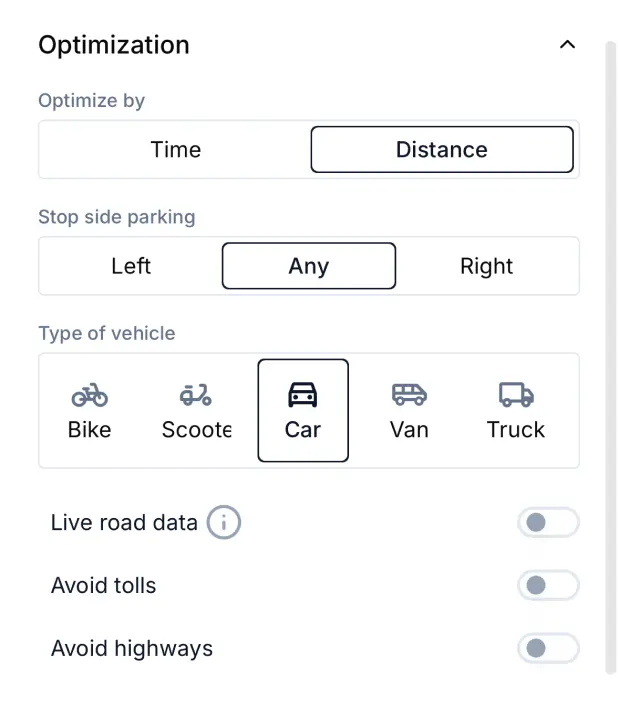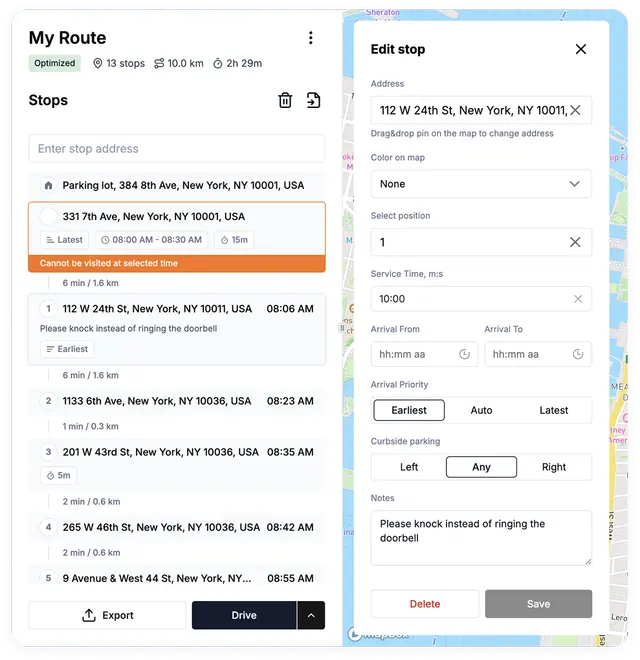Configuring Curbside Preferences and Traffic-Side Options in Routerra

Introduction
Delivery routing involves more than just visiting addresses in sequence. Local driving rules (left-hand vs. right-hand traffic), curbside parking constraints, and individual stop requirements all affect efficiency and safety. In this post, we discuss common curbside-related challenges drivers face worldwide, and how Routerra’s highly configurable traffic-side and curbside settings let you adapt route generation to your local context and personal preferences.
Whether you operate in a left-hand traffic region or drive on the right, and whether some stops demand special approach directions, Routerra offers options to configure defaults and override per-stop. We’ll walk through the pain points, our configuration approach, and practical guidance for using these features to streamline deliveries.
The Curbside Challenge
Many drivers notice inefficiencies when route optimizers ignore approach side and curbside constraints:
- Left-Hand vs. Right-Hand Traffic: In left-hand traffic regions (e.g., Australia, UK, Japan), approaching stops from the “far” side of the road can necessitate unsafe crossings or detours. Conversely, in right-hand traffic regions, the mirror situation applies.
- Curbside Parking Constraints: Some stops require parking on a particular side (e.g., when unloading parcels in busy streets), or approaching from a certain direction to avoid heavy traffic or one-way restrictions.
- Repeated Crossings & Detours: Enforcing a strict curbside approach for every stop may inadvertently cause backtracking, repeated crossing of major roads, or inefficient loops.
- Local Knowledge & Safety: Drivers often know that certain streets or intersections are better approached from one direction due to traffic patterns, parking rules, or safety considerations.
These factors can increase route time, fuel usage, and driver stress. A rigid “always enforce left-side” (or right-side) rule may solve curbside concerns but introduce new inefficiencies. The ideal solution balances approach-side preferences with overall route efficiency, while allowing drivers to apply local knowledge.
Configurable Traffic-Side & Curbside Settings
Routerra addresses these needs through a two-tier configuration system:
-
Default Traffic-Side / Curbside Setting
- Auto: Routerra optimizes purely for efficiency, choosing approach sides that minimize total distance/time, while still respecting hard constraints like one-way streets.
- Left / Right: Forces the optimizer to favor approaching all stops from the chosen side of the road where feasible. This helps in regions where a driver mostly needs curbside parking on that side.
- This default applies globally unless overridden, letting drivers establish a baseline preference according to their regional driving rules.
-
Stop-Level Override
- Even with a global default, some stops benefit from a different approach. Routerra’s route editor displays each stop with a curbside toggle/dropdown: Auto / Left / Right.
- Drivers can review the parsed stops and, for specific locations (e.g., tricky intersections, busy thoroughfares), override the default approach side.
- This hybrid method preserves overall efficiency from “Auto” while enabling precise control where local knowledge dictates.

Balancing Efficiency & Safety
- Start with Auto: For many routes, “Auto” yields the most efficient overall path, letting the optimizer weigh approach directions against total travel time.
- Identify Critical Stops: During route review, flag stops where approach side matters (e.g., across a divided highway, in streets with restricted turns, or busy parking zones). Apply Left/Right override accordingly.
- Minimize Unnecessary Overrides: Overusing per-stop overrides may degrade overall efficiency. Focus on stops where curbside approach yields clear benefits.
- Monitor Route Impact: After applying overrides, review the updated route on the map. Look for unintended loops or extra crossings. Adjust or revert overrides if they introduce significant detours.
Integrating Other Configuration Options
Routerra’s flexible settings work in concert with additional features to fine-tune your workflow:

- Arrival Priority: Mark certain stops as high or low priority. When combined with curbside overrides, you ensure the most urgent stops also respect safe approach sides.
- Time Windows: Specify that a stop must be visited within or after/before certain times. Curbside preferences and time windows can interact: e.g., forcing a left-side approach for a time-sensitive stop during rush hour may require careful optimization.
- Direct Position Changes: Besides drag & drop, you can enter numeric positions for stops. Combined with curbside overrides, you can quickly reorder stops that need special approach.
- Color Differentiation: Tag stops with colors (e.g., red for urgent, blue for bulky items). Visual cues help identify where to check curbside settings or apply overrides.
- Regional Address Parsing & Hints: When importing stops (e.g., via screenshot-based AI-Import), you can supply hints about curbside preferences as metadata, so parsed stops already carry an initial suggested side if known.
- Refreshed UI & Mobile Responsiveness: The route editor clearly indicates overrides and settings per stop, making it easy to review on desktop or mobile before heading out.
Use Cases & Regional Considerations
- Left-Hand Traffic Regions: Drivers often default to “Left” but override to “Auto” or “Right” for certain stops if local roads are easier approached from the opposite side.
- Right-Hand Traffic Regions: Similar logic applies with default “Right”.
- Mixed-Mode Deliveries: Drivers operating near borders or on routes spanning different jurisdictions (e.g., island roads, cross-border services) may switch defaults per route. Routerra allows updating defaults per route or profile.
- Special Deliveries: Bulky or heavy items requiring safe curbside unloading may impose strict approach side; override individual stops accordingly.
- Urban vs. Rural: In dense city centers with one-way systems, curbside preferences can conflict with one-way restrictions; using “Auto” as default but overriding key stops yields balance. In rural areas, approach side may matter less, so “Auto” suffices most of the time.
Key Takeaways
- Flexibility Is Crucial: A one-size-fits-all curbside rule can impair efficiency. Combining a global default with per-stop overrides empowers drivers to harness both optimizer intelligence and local knowledge.
- User-Centered Design: Exposing settings at both global and individual levels, with clear UI cues, ensures drivers understand and can adjust approach preferences without confusion.
- Holistic Configuration: Curbside settings integrate with arrival priorities, time windows, and visual tags, creating a comprehensive toolkit to model real-world delivery constraints.
- Iterate with Feedback: Encourage drivers to test settings on real routes, note inefficiencies, and share insights. Continuous refinement based on real-world use cases strengthens robustness.
- Global Applicability: Whether you drive on the left or right, Routerra’s traffic-side settings adapt to your region. The same UI logic applies universally, just with mirrored defaults.
How to Configure Routerra for Curbside & Traffic-Side Preferences
- Access Settings: In Routerra’s dashboard, find Routing Preferences or Stops Side section. Choose your default: Auto, Left, or Right.
- Import or Build a Route: Use AI-Import, manual entry, or other import methods.
- Open Route Editor: View the list/map of stops. Each stop entry shows a curbside toggle.
- Apply Overrides: For critical stops, select Left or Right override; leave others on Auto.
- Combine with Other Features: Tag stops with colors, set arrival priorities or time windows as needed.
- Optimize & Review: Click “Optimize” and inspect the generated route. Check for repeated crossings or detours; adjust overrides accordingly.
- Drive: Finalize the route and use navigation guidance along.
Encourage team members or fellow drivers to adopt this workflow. Share anonymized route examples and insights to help refine defaults and optimizer logic.
Conclusion
Curbside parking and traffic-side considerations significantly impact delivery efficiency and safety. Routerra’s flexible configuration—global defaults plus stop-level overrides—lets drivers tailor routing to left- or right-hand traffic rules and on-the-ground realities. By combining these settings with arrival priorities, time windows, and visual cues, you create a powerful, adaptable routing tool. Try these options in your next route: set your default, review critical stops, apply overrides where needed, and optimize with confidence. Try Routerra’s curbside tools in your next route — and tell us how it works for you!